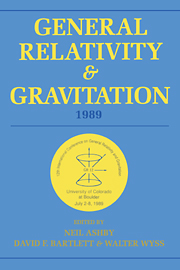 General Relativity and Gravitation, 1989
General Relativity and Gravitation, 1989 Published online by Cambridge University Press: 05 March 2012
Introduction
The methods invented so far to develop conjectures on and to work out the details of the time evolution of gravitational fields fall into two classes. The first class comprises “physical considerations,” techniques of differential geometry and topology and other ideas which do not take into account the field equations while the remaining methods like: study of explicit solutions, of the Cauchy problem local in time (with its important related notions like “domain of dependence,” “Cauchy stability,” etc.), of formal expansion type solutions, of approximation procedures, etc., have been used to derive information about the evolution more or less directly from the field equations. The division above is somewhat artificial, as is illustrated e.g. by the use of certain positivity assumptions together with Raychaudhuri's equations in the proof of the Hawking-Penrose singularity theorems. However, since the field equations are used in this case in a very weak way one obtains quite general results about the occurrence of a non-complete geodesic but almost no information about the expected “singularity.”
In spite of all the ingenuity with which the methods indicated above have been employed, the important open problems of classical general relativity, e.g. the development and (causal) structure of singularities and the formation of horizons etc. for space-times arising from regular data, the asymptotic behavior of gravitational fields and the relation between the far fields and the structure of the sources etc., remained to a large extent unsolved.
To save this book to your Kindle, first ensure [email protected] is added to your Approved Personal Document E-mail List under your Personal Document Settings on the Manage Your Content and Devices page of your Amazon account. Then enter the ‘name’ part of your Kindle email address below. Find out more about saving to your Kindle.
Note you can select to save to either the @free.kindle.com or @kindle.com variations. ‘@free.kindle.com’ emails are free but can only be saved to your device when it is connected to wi-fi. ‘@kindle.com’ emails can be delivered even when you are not connected to wi-fi, but note that service fees apply.
Find out more about the Kindle Personal Document Service.
To save content items to your account, please confirm that you agree to abide by our usage policies. If this is the first time you use this feature, you will be asked to authorise Cambridge Core to connect with your account. Find out more about saving content to Dropbox.
To save content items to your account, please confirm that you agree to abide by our usage policies. If this is the first time you use this feature, you will be asked to authorise Cambridge Core to connect with your account. Find out more about saving content to Google Drive.